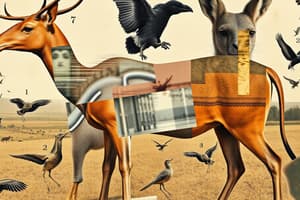Podcast
Questions and Answers
Which of the following phyla includes animals with a pseudocoelom?
Which of the following phyla includes animals with a pseudocoelom?
- Mollusca
- Annelida
- Nematoda (correct)
- Arthropoda
What characteristic is unique to the class Aves?
What characteristic is unique to the class Aves?
- Cold-blooded metabolism
- Presence of mammary glands
- Wings and feathers (correct)
- Use of exoskeleton
Which group of animals is characterized by segmentation?
Which group of animals is characterized by segmentation?
- Cnidarians
- Annelids (correct)
- Porifera
- Echinoderms
What is a defining feature of the phylum Chordata?
What is a defining feature of the phylum Chordata?
In which class would you find organisms that exhibit molting?
In which class would you find organisms that exhibit molting?
Flashcards
Animal Kingdom Classification
Animal Kingdom Classification
A hierarchical system of classifying animals based on shared characteristics and evolutionary relationships.
Phylum
Phylum
A major taxonomic group of animals with shared characteristics.
Characteristics of animals
Characteristics of animals
Features shared by all animals, such as multicellularity, heterotrophic nutrition, and movement.
Invertebrate characteristics
Invertebrate characteristics
Signup and view all the flashcards
Vertebrate characteristics
Vertebrate characteristics
Signup and view all the flashcards
Study Notes
Chapter 11: Animal Kingdom - Class 11 Biology
-
What are the characteristics of animals?
- Heterotrophic nutrition
- Multicellular eukaryotic organisms
- Absence of chlorophyll
- Motility in some stage of their life
- Eukaryotic cells
- Ability to reproduce sexually
-
What are the different ways animals are classified?
- Based on body symmetry (asymmetry, radial symmetry, bilateral symmetry)
- Based on presence or absence of coelom (acoelomate, pseudocoelomate, coelomate)
- Based on patterns of embryonic development (protostomes, deuterostomes)
- Based on presence or absence of segmentation
- Based on presence or absence of notochord
- Presence or absence of a backbone (invertebrates and vertebrates).
Invertebrates
-
Porifera (Sponges):
- Multicellular, no true tissues or organs
- Sessile (attached to a surface)
- Spicules for support
- Filter feeders
- Example: Sycon, Spongilla, Euspongia
-
Coelenterata (Cnidarians):
- Radially symmetrical
- Two germ layers (diploblastic)
- Cnidocytes (stinging cells) for defense and capturing prey
- Gastrovascular cavity
- Example: Hydra, Obelia, Jellyfish, Sea anemones
-
Platyhelminthes (Flatworms):
- Bilaterally symmetrical
- Acoelomate (no body cavity)
- Triploblastic (three germ layers)
- Flattened body
- Example: Planaria, Fasciola (liver fluke), Taenia (tapeworm)
-
Nematoda (Roundworms):
- Bilaterally symmetrical
- Pseudocoelomate
- Cylindrical body
- Complete digestive system
- Example: Ascaris, Wuchereria
-
Annelida (Segmented Worms):
- Bilaterally symmetrical
- Coelomate
- Body segmented into metameres
- Example: Earthworm, leech, Nereis
-
Mollusca:
- Bilaterally symmetrical
- Coelomate
- Soft body, often with a shell
- Mantle cavity, muscular foot
- Example: Snail, oyster, octopus, squid
-
Arthropoda:
- Largest phylum
- Bilaterally symmetrical
- Jointed appendages
- Exoskeleton made of chitin
- Segmented body
- Example: Cockroach, spider, butterfly, crab
-
Echinodermata:
- Radially symmetrical (in adult form)
- Deuterostomes
- Water vascular system
- Spiny skin
- Example: Starfish, sea urchin, sea cucumber
-
Hemichordata:
- Marine animals
- Bilaterally symmetrical
- Dorsoventrally flattened
- Example: Balanoglossus
Vertebrates
-
Chordata:
- Notochord
- Dorsal hollow nerve cord
- Pharyngeal slits
- Post-anal tail
- Divided into:
- Pisces (Fishes):
- Aquatic, water breathing, fins for locomotion
- Amphibia:
- Moist skin, undergo metamorphosis
- Example: Frog, toad, salamander
- Reptilia:
- Scaly skin, lay amniotic eggs
- Example: Snake, lizard, crocodile, turtle
- Aves:
- Feathers, lay amniotic eggs, have wings, forelimbs modified into wings
- Example: Sparrow, owl, parrot, eagle
- Mammalia:
- Mammary glands, hair or fur, three middle ear bones, high metabolic rate, most viviparous
- Example: Cat, dog, human, bat, whale
- Pisces (Fishes):
-
Key characteristics distinguishing vertebrates from invertebrates
- Presence of an internal skeleton (endoskeleton)
- Presence of a backbone and a cranium (skull)
- More developed nervous system
Important Concepts
-
Phylogeny: the evolutionary history of a group of organisms
-
Classification: arranging organisms into groups based on shared characteristics
-
Evolutionary relationships: illustrating connections between organisms on a phylogenetic tree.
-
Adaptive radiation: diversification of one species into multiple forms
-
Animal diversity in different habitats of the Earth.
-
Economic importance of animals (e.g., food, medicine, agriculture).
-
Threats to various animal species (e.g., habitat loss, pollution).
-
Conservation strategies to protect endangered animals.
Studying That Suits You
Use AI to generate personalized quizzes and flashcards to suit your learning preferences.
Description
Explore the fascinating features of the animal kingdom in this quiz based on Chapter 11 of Class 11 Biology. Test your knowledge on the characteristics of animals, their classifications, and specific groups like Porifera. Perfect for students preparing for biology exams!




